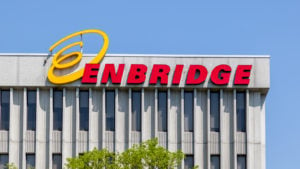One of the easiest ways to get paid consistently is with income investing. Simply buy a high-yielding, growing stock and sit back and collect the yield.
Look at Kinder Morgan (NYSE:KMI), one of the largest energy infrastructure companies in North America. Not only is it a well-respected, growing company, but it has now consistently increased its dividend going on seven years. Also, according to a recent press release, the company said, “We are projecting an annualized dividend of $1.15 in 2024, constituting the 7th year in a row in which we have increased our dividend.”
Some of the other top income investing stocks that should generate a steady paycheck in 2024, include:
Vanguard High Dividend Yield ETF (VYM)

Source: Shutterstock
Let’s start with investing stocks, like the Vanguard High Dividend Yield ETF (NYSEARCA:VYM), which tracks the FTSE High Dividend Yield Index.
With a very low expense ratio of 0.06%, the fund yields about 3.1% at the moment. While that’s not a significant payout, it’s a consistent one for those looking for something dependable. Plus, the fund allows you to diversify with 450 top stocks.
While the ETF did rocket from about $98 to $111.63 in recent months – and is overdue for some healthy profit taking – it could eventually see higher highs. Right now, what concerns me in the immediate term are the over-extensions on RSI, MACD and Williams’. Longer term, following a healthy pullback, I do see this fund pushing higher.
Roundhill S&P Dividend Monarchs ETF (KNGS)

Source: Shutterstock
Another one of the top income investing stocks to own is the Roundhill S&P Dividend Monarchs ETF (NYSEARCA:KNGS), which just started trading in November.
With an expense ratio of 0.35%, it has 35 holdings and tracks the S&P 500 Dividend Monarchs Index. It also carries a yield of 3.5% at the moment. Some of its top holdings include 3M (NYSE:MMM), Black Hills (NYSE:BKH), Target (NYSE:TGT), AbbVie (NYSE:ABBV), Kevnue (NYSE:KVUE), Coca-Cola(NYSE:KO), Johnson & Johnson (NYSE:JNJ) and Hormel Foods (NYSE:HRL) to name a few.
Realty Income (O)

Source: Shutterstock
The last time I mentioned Realty Income (NYSE:O), it traded around $53.25 on November 27. Today, it’s up to $57.42 and could test higher highs, especially with the Federal Reserve expected to cut interest rates three to four times in 2024.
Better, the company, which bills itself as “The Monthly Dividend Company,” carries a yield of 5.36% and just declared its 123rd monthly cash dividend of $0.2565. That’s payable January 12 to stockholders of record as of January 2.
Realty Income has been around for more than 50 years now, and has managed to survive any and all economic chaos. Plus, it has 13,250 properties, with an occupancy rate of 99%.
AT&T (T)

Source: Shutterstock
With a yield of 6.62%, AT&T (NYSE:T) is another hot dividend-paying stock to buy and hold. It also just declared a quarterly dividend of $0.2775 per share, which is payable February 1 to shareholders of record as of January 10. Even better, after a brief dip from $17.25 to $16.25, it’s already starting to pivot higher.
Plus, AT&T director Stephen Luczo just bought $971,875 worth of AT&T stock, and Bank of America just named the stock its top telecom pick for the new year.
Citigroup also raised its price target to $18, with a buy rating. As noted by TheFly.com, “The firm continues to recommend AT&T as it sees opportunities to improve financial performance with strategic volume growth, reduce net debt leverage and support its dividend payout.”
American States Water (AWR)

Source: HQuality/ShutterStock.com
With a yield of 2.14%, American States Water (NYSE:AWR) is a reliable water and electric utility company that’s been around since 1929. At the moment, the company serves over a million people across nine states. Also, for the last 69 years, it has also increased its dividend.
In fact, it just increased it again to 43 cents, payable December 1 to shareholders of record at the close of business on November 15. With AWR, not only are you buying a reliable company, you’re owning a company with good financial stability.
Kimberly-Clark (KMB)

Source: Trong Nguyen / Shutterstock.com
There’s also Kimberly-Clark (NYSE:KMB), a global products company that’s been around for 151 years, operates in 175 countries, carries a yield of 3.88%. Just recently it declared a quarterly dividend of $1.18 per share, which is payable on January 3, 2024, to shareholders on record, as of December 8.
Earnings and guidance haven’t been too shabby either. In fact, KMB recently raised its 2023 outlook after third-quarter results beat on EPS of $1.73 per diluted share, as compared to $1.38 per share year over year. Organic sales growth was raised to a new range of 4% to 5%, as compared to its prior forecast of 3% to 5%. Net sales growth was raised to a range of 1% to 2% from its prior range of 0% to 2%.
Not long ago, Piper Sandler initiated coverage of KMB with an overweight rating, with a price target of $146. Barclays also raised its price target to $123, with an equal weight rating.
Enbridge (ENB)

Source: JHVEPhoto / Shutterstock.com
With a dividend yield of about 7.5%, Enbridge (NYSE:ENB) is a lower risk, high yield opportunity that should keep your portfolio safe from chaos. The company has a wide moat and has the second longest natural gas pipeline in the U.S., and North America’s longest crude oil pipeline.
Even better, the company just announced its 29th consecutive dividend increase, raising it by 3.1% to $0.915 per quarter ($3.66 annualized), effective March 1, 2024, as noted in a company press release. Plus, as noted by Greg Ebel, President and CEO of Enbridge, “We remain committed to annual dividend growth consistent with our medium-term distributable cash flow outlook and keeping our dividend payout ratio within 60-70% of DCF.”
On the date of publication, Ian Cooper did not have (either directly or indirectly) any positions in the securities mentioned. The opinions expressed in this article are those of the writer, subject to the InvestorPlace.com Publishing Guidelines.

